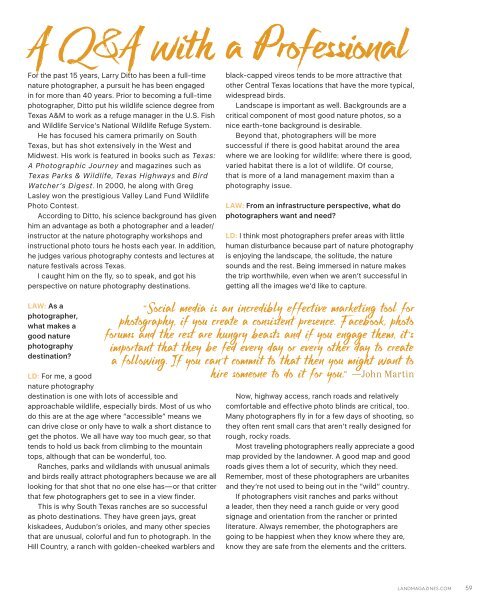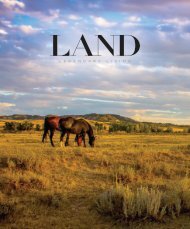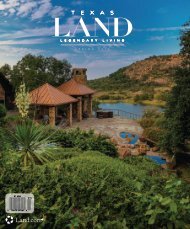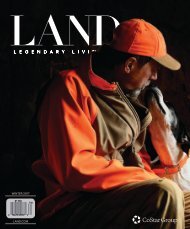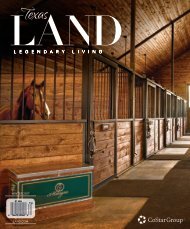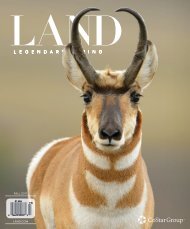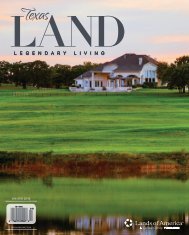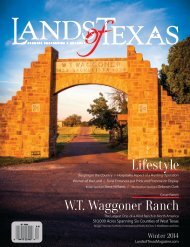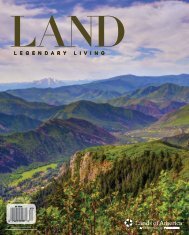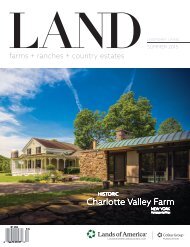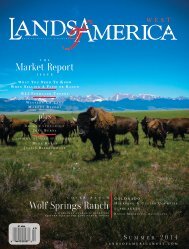Spring 2017
Texas LAND
Texas LAND
You also want an ePaper? Increase the reach of your titles
YUMPU automatically turns print PDFs into web optimized ePapers that Google loves.
A Q&A with a Professional<br />
For the past 15 years, Larry Ditto has been a full-time<br />
nature photographer, a pursuit he has been engaged<br />
in for more than 40 years. Prior to becoming a full-time<br />
photographer, Ditto put his wildlife science degree from<br />
Texas A&M to work as a refuge manager in the U.S. Fish<br />
and Wildlife Service’s National Wildlife Refuge System.<br />
He has focused his camera primarily on South<br />
Texas, but has shot extensively in the West and<br />
Midwest. His work is featured in books such as Texas:<br />
A Photographic Journey and magazines such as<br />
Texas Parks & Wildlife, Texas Highways and Bird<br />
Watcher’s Digest. In 2000, he along with Greg<br />
Lasley won the prestigious Valley Land Fund Wildlife<br />
Photo Contest.<br />
According to Ditto, his science background has given<br />
him an advantage as both a photographer and a leader/<br />
instructor at the nature photography workshops and<br />
instructional photo tours he hosts each year. In addition,<br />
he judges various photography contests and lectures at<br />
nature festivals across Texas.<br />
I caught him on the fly, so to speak, and got his<br />
perspective on nature photography destinations.<br />
LAW: As a<br />
photographer,<br />
what makes a<br />
good nature<br />
photography<br />
destination?<br />
LD: For me, a good<br />
nature photography<br />
destination is one with lots of accessible and<br />
approachable wildlife, especially birds. Most of us who<br />
do this are at the age where “accessible” means we<br />
can drive close or only have to walk a short distance to<br />
get the photos. We all have way too much gear, so that<br />
tends to hold us back from climbing to the mountain<br />
tops, although that can be wonderful, too.<br />
Ranches, parks and wildlands with unusual animals<br />
and birds really attract photographers because we are all<br />
looking for that shot that no one else has—or that critter<br />
that few photographers get to see in a view finder.<br />
This is why South Texas ranches are so successful<br />
as photo destinations. They have green jays, great<br />
kiskadees, Audubon’s orioles, and many other species<br />
that are unusual, colorful and fun to photograph. In the<br />
Hill Country, a ranch with golden-cheeked warblers and<br />
black-capped vireos tends to be more attractive that<br />
other Central Texas locations that have the more typical,<br />
widespread birds.<br />
Landscape is important as well. Backgrounds are a<br />
critical component of most good nature photos, so a<br />
nice earth-tone background is desirable.<br />
Beyond that, photographers will be more<br />
successful if there is good habitat around the area<br />
where we are looking for wildlife: where there is good,<br />
varied habitat there is a lot of wildlife. Of course,<br />
that is more of a land management maxim than a<br />
photography issue.<br />
LAW: From an infrastructure perspective, what do<br />
photographers want and need?<br />
LD: I think most photographers prefer areas with little<br />
human disturbance because part of nature photography<br />
is enjoying the landscape, the solitude, the nature<br />
sounds and the rest. Being immersed in nature makes<br />
the trip worthwhile, even when we aren’t successful in<br />
getting all the images we’d like to capture.<br />
“Social media is an incredibly effective marketing tool for<br />
photography, if you create a consistent presence. Facebook, photo<br />
forums and the rest are hungry beasts and if you engage them, it’s<br />
important that they be fed every day or every other day to create<br />
a following. If you can’t commit to that then you might want to<br />
hire someone to do it for you.” —John Martin<br />
Now, highway access, ranch roads and relatively<br />
comfortable and effective photo blinds are critical, too.<br />
Many photographers fly in for a few days of shooting, so<br />
they often rent small cars that aren’t really designed for<br />
rough, rocky roads.<br />
Most traveling photographers really appreciate a good<br />
map provided by the landowner. A good map and good<br />
roads gives them a lot of security, which they need.<br />
Remember, most of these photographers are urbanites<br />
and they’re not used to being out in the “wild” country.<br />
If photographers visit ranches and parks without<br />
a leader, then they need a ranch guide or very good<br />
signage and orientation from the rancher or printed<br />
literature. Always remember, the photographers are<br />
going to be happiest when they know where they are,<br />
know they are safe from the elements and the critters.<br />
LANDMAGAZINES.COM<br />
59


